|
|
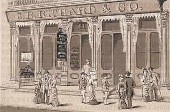 Office at 61 Brodway, New York
Office at 61 Brodway, New York
 Hamburg America Line Pier
Hamburg America Line Pier, foot of Third St. Hoboken S/S Wieland)
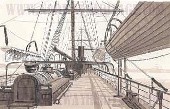 Deck view, Hamburg America Line Steamship ca. 1876
Deck view, Hamburg America Line Steamship ca. 1876
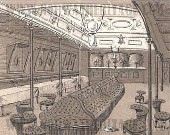 Saloon - First Cabin
Saloon - First Cabin on the Hamburg America Line steamship Gellert, Herder, Lessing, Wieland)
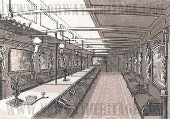 Saloon - First cabin, Hamburg America Line ca. 1876
Saloon - First cabin, Hamburg America Line ca. 1876
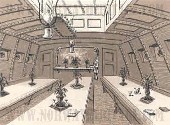 Saloon - Second Cabin, Hamburg America Line ca. 1876
Saloon - Second Cabin, Hamburg America Line ca. 1876
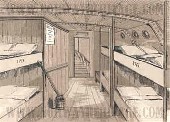 Steerage accommodation, Hamburg America Line ca. 1876 Steerage accommodation, Hamburg America Line ca. 1876
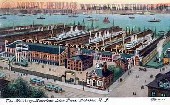 Hamburg America Line landing stage in Hoboken
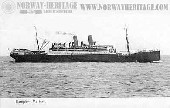
S/S Moltke
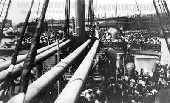 Passengers arriving New York on the Moltke
 Augusta Victoria, Nordlandfahrten
.jpg) The S/S Deutschland(3)
|
|
HAMBURG-AMERICAN PACKET COMPANY.
All the Company's Ocean Steamers have been constructed on the river Clyde by the famous engineers and iron ship builders CAIRD & Co. in Greenock. R. NAPIER & SONS and ALEX. STEPHENS & SONS in Glasgow, and carry the Uniten States and European Mails.
They are amnned by 142 mn, distrbuted as follows: 29 deckhands under 4 officers and 9 petty officers; 32 firemen, coalheavers and machinists under 8 engineers, and 57 stewards, cooks, helpers, trimmers etc.
The Steamers of this Line leave New York from Hamburg Pier, foot of Third Street, Hoboken, Every Thursday and nearly every alternate Saturday, taking passengers for PLYMOUTH, LONDON, CHERBOURG, PARIS and HAMBURG. This arrangement renders the Line a means of direct transportation to England, France and Germany, and at the same time accommodates travelers an route for the Continent, who would avoid the discomforts of crossing the English Channel.
The Railway transit from Plymouth to London occupies only 6 hours from Cherbourg to Paris 8 hours. Returning the Steamers of the Hamburg Line leave Hamburg Every Wednesday and Havre Every Saturday. Passengers will be forwarded from Southampton or London to havre at the Company's expense. The time by rail from Paris to Havre being only 4 hours, a direct communication between France and the United States is formed, which offers every desirable facilities for Passengers coming from Paris or any other part of the Continent.
The First Cabin is fitted up in magnificent style-the walls are tastefully ornamented, seats and lounge are made in whatever upholsrers' and cabinetmakers' handicraft can provide. The space under the seats of the sofas in the different staterooms is 14 1/2 inches high. The staterooms, of which a large number are located amidships, are 7 to 9 feet in width. A Ladies Sitting-room and a fine Promenade Deck add to the comfort of these steamers.
The Second Cabin is on the same deck forward of the First Cabin; it is comfortably furnished and also heated by steam; the surrounding staterooms are well lighted and ventilated. Both Saloons have large staterooms set apart for ladies traveling alone, and Conversation and Smoking Rooms, elegantly fitted up, offering to gentlemen al the opportunities for social intercourse.
The Steerage is situated directly below the Second Cabin. It is spacious, light and well ventilated, and has separate compartments for single men, women and families. An efficient corps of stewards and servants, speaking several languages, is ready under the superintendence of experienced Chief Stewards and Stewardesses to attend the wants of the passengers. The Kitchens are on the upper deck, thereby avoiding odors generally so obnoxious to passengers. An experienced physician is attached to every steamer. For medical attendance and medicines no charge will be made. During preceding years the Steamers of the Hamburg-American Packet Company have maintained their splendid record for safety, speed and comfort, and proved themselves worthy of high repute in which they are held by the traveling public.
(From a booklet issued by the line about 1876)
|
The Hamburg America Line was the first German transatlantic steamship line, established in 1847. The people behind the foundation of the company was ship broker August Bolten, ship owner Ferdinand Laiesz and banker Adolph Halle. With support from other Hamburg business leaders they founded the company under the name Hamburg Amerikanische Packetfahrt Actien Gesellschaft (HAPAG). In Norway this company was first referred to as August Bolten's steamship line.
Many Norwegian emigrants traveled via Germany on their way to North America. This was not the most common route, as most Norwegian emigrants traveled via Britain. The majority of Norwegians traveling on the German ships, had to make the first step of their voyage on a feeder ship to Germany. There were regular routes between Norwegian ports and the German ports of Hamburg and Bremen. The main transatlantic companies operating routes between German ports and North America was the Hamburg America Line (HAPAG), and the North German Lloyd (Norddeutcher Loyd). The North German Lloyd (NDL) had a service between Bremen and New York.
By 1896 the line owned a fleet of 102 vessels, with an aggregate of 269,502 tons. It was at the time the only line maintaining a twin-screw express service between the continents of Europe and America. The company maintained nineteen separate steamship services, besides winter and summer cruises with twin-screw express steamships. The Hamburg America Line operated routes between Hamburg and New York. Some years their ships also called at Southampton to take on passengers. The Southampton service was not very popular with the British companies. For several years the Hamburg America Line also operated a route between Stettin, Copenhagen and New York. This route was in sharp competition to the Danish company, the Thingvalla Line, later called the Scandinavian America Line. The Hamburg America Line also maintained a direct service between Norwegian ports and America, in the years 1893 - 1895. Their ships had departures from the ports of (Christiania) and Christiansand, mainly from Christiansand. They operated in Norway under the name Scandia Line. The service was taken up again in the summer of 1903, and continued till the autumn of 1904.
The fleet of twin-screw express steamships of the company which operated the service between New York to Plymouth, Cherbourg and Hamburg, and from Hamburg, Southampton, and Cherbourg to New York, were the Auguste Victoria and the Furst Bismark, built by the Vulcan Shipbuilding Company at Stettin, the Columbia, built by Laird Bros., in Birkenhead, and the Normannia built by the Fairfield Shipbuilding Company, in Glasgow. With these vessels the company maintained a
weekly express service, offering the public the convenience of traveling between America and the European Continent with
absolute safety, in the shortest possible time, and with a degree of comfort that was unexcelled.
FROM A 1896 BOOKLET:
"The problem which the owners and designers intended to solve in building these magnificent vessels was to produce ships which would offer absolute safety, and at the same time, be able to make the swiftest voyages with the greatest comfort to the passengers. To realize this, they spared neither trouble nor expense, and have now the satisfaction of seeing before them, in heir new steamships, models of the latest phase if marine architecture, advancing far beyond anything previously attempted; as beautiful in outline as they arc practical in their interior arrangements, and absolutely perfect in the three requirements of
modern ocean travel, safety, Speed and Comfort.
What first strikes the observer are the graceful lines which run from the sharp, straight, stem to the well-rounded stern. Three funnels rise from the hurricane deck, which, although of huge dimensions, only serve to bring out the symmetry of the whole. The COLUMBIA has three masts, the AGUSTE VICTORIA, FURST BISMARCK and NORMANNIA two, which are low and
without yards, so as to offer the least resistance. So beautiful are the lines of these ships that it is difficult for the spectator to realize their immense size. These leviathans have a length of 465 to 525 feet, a width of 56 to 58 feet, and a depth of 38 to 40
feet; are of 7 578 to 8 874 tons register, and their engines develop the force of 23 000 to 16 000 horses. They have five decks, constructed solidly of steel and teak wood, the upper decks ending in strong turtle-backs at the bow and stern. These
steamships are the largest and fastest ships of the German merchant marine. The first consideration which the builders had in
view was that of absolute safety, and they have built ships which are practically unsinkable. Many novel features have been
introduced to bring this about, of which the principal ones are here set forth.
The new vessels have their whole working machinery duplicated. There are two distinct sets of boilers, two engines, two shafts, and two screws, both sets working independently of each other, and separated by a longitudinal bulkhead dividing the vessel into two non-communicating halves, each of which is fully equipped to propel the ship. This is the great principle of twin-screw steamships and the
extraordinary degree of safety secured by this system is obvious, for an accident to one side of the ship can in nowise affect
the other, whose machinery will continue to work and propel the ship with perfect ease and at a high rate of speed.
Each side of the ship is again subdivided into numerous watertight compartments, which do not communicate with each other.
The hull of the ship has a double bottom, the space between being divided into chambers, which can be filled with water or
emptied by means of automatic pumps, thus increasing or decreasing the draught at will, and guarding against accidents from
grounding. The enormous engines of 6 000 to 8 000 horse-power each. The screws are of manganese bronze, with three or four blades.
The Hamburg-American Line holds the record for fastest time across the Atlantic from New York to Southampton and the continent. The best time accomplished was 6 days 10 hours 32 minutes between New York and Southampton. The landing arrangements at Plymouth are considered superior to those of any other port in England, and the Hamburg-American Line's special trains starting from the landing place await the passengers there. During past years these steamships have maintained a regular fast weekly express service between New York, Southampton, and Hamburg, and lately between New York, Plymouth, Cherbourg and Hamburg, taking passengers to London within 7 days, while the actual average ocean passage is reduced to a little more than 6 days.
Passengers leaving New York on Thursday are landed in Plymouth and Cherbourg on the following Thursday, reaching Paris and London on the same day, thus bringing them from New York to London in less than a week (it has been done in 6 days 14 hours, a feat not equaled by any other line). This shows the wonderful convenience which these steamships offer to the travelling public.
The fastest runs were about 20 ¼ knots per hour, which is equal to 2318 English miles, and exceeds the speed of transcontinental trains."
For passengers traveling on HAPAG ships via Hamburg the Norwegian Emigration Protocols will only give the name of the ship that brought the emigrants from Norway to Hamburg. Note that some Norwegians traveling on German ships would choose a rout from Norway to Denmark by ship, and from Denmark to Germany by train, the Hamburg America Line also called at English ports. See also Scandia Line.
Hamburg America Line picture gallery
Go here to read the passenger list for the Gothia leaving Christiansand on 28th July 1894
|
| Type | Name of ship  | Year Built  | Construction Shipyard  | Tonnage (burthen)  |
|---|
| S/S | Polynesia (2) | 1904 | | 6,022 gross | | ship | Deutschland (2) | 1858 | | 867 gross | | S/S | Marsala | | | | | S/S | Sorrento | | | | | S/S | Taormina | | | | | S/S | Moravia | 1883 | A. & J. Inglis | 3,739 gross | | S/S | Bohemia (1) | 1881 | A. & J. Inglis | 3,410 gross | | S/S | Palatia | 1894 | AG Vulcan | 7,326 gross | | S/S | Deutschland (3) | 1900 | AG Vulcan | 16,502 gross | | S/S | Scandia | 1889 | AG Vulcan | 4,243 gross | | S/S | Hamburg (1) | 1899 | AG Vulcan | 10,532 gross | | S/S | Patricia | 1899 | AG Vulcan | 13,023 gross | | S/S | Rugia (1) | 1882 | AG Vulcan | 3,467 gross | | S/S | Patria | 1894 | AG Vulcan | 7,118 gross | | S/S | Dania | 1889 | AG Vulcan | 4,076 gross | | S/S | Furst Bismarck (1) | 1890 | AG Vulcan | 8,430 gross | | S/S | Victoria Luise | 1900 | AG Vulcan | 16,502 gross | | S/S | Imperator | 1912 | AG Vulcan | 51,969 gross | | S/S | Hansa (2) | 1900 | AG Vulcan | 16,502 gross | | S/S | Kaiserin Auguste Victoria | 1905 | AG Vulcan | 24,581 gross | | S/S | Auguste Victoria | 1881 | AG Vulcan | 7,661 gross | | S/S | Kiautschou | 1900 | AG Vulcan | 10,911 gross | | S/S | Augusta Victoria | 1881 | AG Vulcan | 7,661 gross | | S/S | Konig Wilhelm II | 1907 | AG Vulcan | 9,410 gross | | S/S | Resolute | 1914 | AG Weser | 19,653 gross | | S/S | Lessing | 1874 | Alexander Stephen & Sons | 3,496 gross | | S/S | Bethania | 1899 | Alexander Stephen & Sons | 0 gross | | S/S | Pisa | 1896 | Alexander Stephen & Sons | 4,967 gross | | S/S | Chemnitz | 1889 | Alexander Stephen & Sons | 2,758 gross | | S/S | Gellert | 1874 | Alexander Stephen & Sons | 3,533 gross | | S/S | Wieland | 1874 | Alexander Stephen & Sons | 3,507 gross | | S/S | Herder | 1873 | Alexander Stephen & Sons | 3,494 gross | | S/S | California | 1883 | Armstrong, Mitchell & Co. | 2,690 gross | | S/S | Italia | 1889 | Armstrong, Mitchell & Co. | 3,564 gross | | S/S | Bolivia | 1889 | Armstrong, Mitchell & Co. | 2,646 gross | | S/S | Barmen | 1889 | Armstrong, Mitchell & Co. | 2,646 gross | | S/S | Hercynia | 1889 | Armstrong, Mitchell & Co. | 2,630 gross | | S/S | Georgia | 1890 | Barclay, Curle & Co. Ltd. | 3,143 gross | | S/S | Pickhuben | 1890 | Barclay, Curle & Co. Ltd. | 3,143 gross | | S/S | Hansa (3) | 1922 | Blohm & Voss | 20,815 gross | | M/S | Milwaukee | 1929 | Blohm & Voss | 16,699 gross | | S/S | Moltke | 1901 | Blohm & Voss | 12,335 gross | | S/S | Konig Friedrich August | 1906 | Blohm & Voss | 0 gross | | S/S | New York | 1926 | Blohm & Voss | 21,455 gross | | S/S | Meteor | 1904 | Blohm & Voss | 3,613 gross | | S/S | Graf Waldersee | 1898 | Blohm & Voss | 12,830 gross | | S/S | Hamburg (2) | 1925 | Blohm & Voss | 21,133 gross | | S/S | Phoenicia | 1894 | Blohm & Voss | 7,155 gross | | S/S | Baumwall | 1890 | Blohm & Voss | 2,811 gross | | S/S | Bulgaria | 1898 | Blohm & Voss | 10,237 gross | | S/S | Christiania | 1890 | Blohm & Voss | 2,811 gross | | S/S | Prinzessin Victoria Luise | 1901 | Blohm & Voss | 4,409 gross | | S/S | Blucher | 1902 | Blohm & Voss | 12,334 gross | | S/S | Belgravia | 1899 | Blohm & Voss | 10,155 gross | | S/S | Pretoria | 1897 | Blohm & Voss | 12,800 gross | | S/S | Cleveland | 1908 | Blohm & Voss | 16,960 gross | | S/S | Segovia | 1900 | Blohm & Voss | 0 gross | | S/S | Batavia | 1899 | Blohm & Voss | 10,178 gross | | S/S | Deutschland (4) | 1923 | Blohm & Voss | 20,602 gross | | S/S | Vaterland | 1913 | Blohm & Voss | 54,282 gross | | S/S | Virginia | 1891 | Blohm & Voss | 2,820 gross | | S/S | Antonina | 1898 | Blohm & Voss | 8,099 gross | | S/S | Albert Ballin | 1922 | Blohm & Voss | 20,815 gross | | M/S | St. Louis | 1928 | Bremer Vulcan | 16,732 gross | | S/S | Oceana (3) | 1912 | Bremer Vulcan | 0 gross | | S/S | Wurttemberg | 1921 | Bremer Vulcan | 8,829 gross | | S/S | Bayern (2) | 1921 | Bremer Vulcan | 8,917 gross | | S/S | Rugia (2) | 1905 | Bremer Vulcan | 6,598 gross | | S/S | Prinz Adalbert | 1902 | Bremer Vulcan | 6,030 gross | | S/S | Prinz Oskar | 1902 | Bremer Vulcan | 6,026 gross | | S/S | Rhenania (3) | 1904 | Bremer Vulcan | 6,403 gross | | S/S | Rhaetia (2) | 1904 | Bremer Vulcan | 6,600 gross | | S/S | Allemannia (1) | 1865 | C. A. Day & Co | 2,695 gross | | S/S | Polaria | 1882 | C. Mitchell & Co. | 2,724 gross | | S/S | Polynesia (1) | 1881 | C. Mitchell & Co. | 2,196 gross | | S/S | Australia | 1881 | C. Mitchell & Co. | 2,119 gross | | S/S | Pallanza | 1891 | C. S. Swan & Hunter | 4,606 gross | | S/S | Hammonia (1) | 1855 | Caird & Co. | 2,026 gross | | S/S | Borussia | 1855 | Caird & Co. | 2,131 gross | | S/S | Hammonia (2) | 1866 | Caird & Co. | 3,035 gross | | S/S | Bavaria | 1856 | Caird & Co. | 2,405 gross | | S/S | Germania (1) | 1863 | Caird & Co. | 2,123 gross | | S/S | Franconia | 1872 | Caird & Co. | 3,098 gross | | S/S | Germania (2) | 1870 | Caird & Co. | 2,876 gross | | S/S | Cimbria | 1867 | Caird & Co. | 3,037 gross | | S/S | Frisia | 1872 | Caird & Co. | 3,500 gross | | S/S | Austria | 1857 | Caird & Co. | 2,684 gross | | S/S | Westphalia (1) | 1868 | Caird & Co. | 3,158 gross | | S/S | Vandalia | 1871 | Caird & Co. | 2,810 gross | | S/S | Thuringia (1) | 1870 | Caird & Co. | 3,133 gross | | S/S | Teutonia | 1856 | Caird & Co. | 2,693 gross | | S/S | Suevia | 1874 | Caird & Co. | 3,609 gross | | S/S | Silesia | 1869 | Caird & Co. | 3,142 gross | | S/S | Holsatia (1) | 1868 | Caird & Co. | 3,134 gross | | S/S | Saxonia | 1857 | Caird & Co. | 2,684 gross | | S/S | Rhenania (1) | 1873 | Caird & Co. | 2,989 gross | | S/S | Pommerania | 1873 | Caird & Co. | 3,382 gross | | S/S | Scotia | 1890 | Charles Connell & Co. | 2,558 gross | | S/S | Stubbenhuk | 1890 | Charles Connell & Co. | 2,922 gross | | S/S | Sicilia | 1890 | Charles Connell & Co. | 2,922 gross | | S/S | Sarnia | 1882 | Charles Connell & Co. | 3,728 gross | | S/S | Grimm | 1890 | Charles Connell & Co. | 2,558 gross | | S/S | Oregon | 1882 | Charles Connell & Co. | 3,672 gross | | S/S | Allemannia (2) | 1881 | Dobie & Co. | 1,846 gross | | S/S | Albingia (1) | 1881 | Dobie & Co. | 1,848 gross | | S/S | Rhenania (2) | 1880 | Dobie & Co. | 1,846 gross | | S/S | Markomannia | 1890 | Edwards Shipbuilding Co. | 3,335 gross | | S/S | Kaiser Friedrich | 1897 | F. Schichau | 12,480 gross | | S/S | Cincinnati | 1908 | F. Schichau | 16,339 gross | | S/S | Normannia (2) | 1890 | Fairfield Shipbuilding & Eng. Co. Ltd. | 8,242 gross | | S/S | Furst Bismarck (2) | 1905 | Fairfield Shipbuilding & Eng. Co. Ltd. | 8,332 gross | | S/S | Ambria | 1896 | Flensburger Schiffbau | 5,463 gross | | S/S | Aragonia | 1897 | Flensburger Schiffbau | 5,446 gross | | S/S | Essen | 1889 | Flensburger Schiffbau | 2,939 gross | | S/S | Prinz Joachim | 1903 | Flensburger Schiffbau | 4,760 gross | | S/S | Silvia | 1901 | Flensburger Schiffbau | 6,506 gross | | S/S | Prinz August Wilhelm | 1902 | Flensburger Schiffbau | 4,733 gross | | S/S | Alesia | 1896 | Flensburger Schiffbau | 5,476 gross | | S/S | Badenia | 1902 | Furness, Withy & Co. | 6,416 gross | | S/S | Corcovado | 1907 | Germania Werft | 8,099 gross | | S/S | Ypiranga | 1908 | Germania Werft | 8,142 gross | | S/S | Brasilia | 1897 | Harland & Wolff | 10,336 gross | | S/S | Persia | 1894 | Harland & Wolff | 5,857 gross | | S/S | Pennsylvania | 1896 | Harland & Wolff | 12,891 gross | | S/S | President Grant | 1903 | Harland & Wolff | 18,072 gross | | S/S | Bohemia (2) | 1902 | Harland & Wolff | 8,370 gross | | S/S | President Lincoln | 1903 | Harland & Wolff | 18,084 gross | | S/S | Amerika | 1905 | Harland & Wolff | 22,225 gross | | S/S | Barcelona | 1896 | Harland & Wolff | 5,446 gross | | S/S | Prussia (1) | 1893 | Harland & Wolff | 5,965 gross | | S/S | Arabia | 1896 | Harland & Wolff | 5,446 gross | | S/S | Albingia (2) | 1893 | Harland & Wolff | 4,630 gross | | S/S | Arcadia | 1896 | Harland & Wolff | 5,442 gross | | S/S | Albano | 1886 | Harland & Wolff | 3,747 gross | | S/S | Allemannia (3) | 1892 | Harland & Wolff | 4,630 gross | | S/S | Thuringia (4) | 1922 | Howaldtswerke | 11,343 gross | | S/S | Westphalia (3) | 1923 | Howaldtswerke | 11,343 gross | | S/S | Klopstock | 1874 | J. & G. Thomson & Co. | 3,659 gross | | S/S | Hammonia (3) | 1881 | J. & G. Thomson & Co. | 4,247 gross | | S/S | Assyria | 1898 | J. C. Tecklenborg | 6,581 gross | | S/S | Wandrahm | 1890 | J. C. Tecklenborg | 2,578 gross | | S/S | Reliance | 1914 | J. C. Tecklenborg | 19,582 gross | | S/S | Hispania | 1890 | J. C. Tecklenborg | 2,578 gross | | S/S | Cremon | 1871 | James Laing & Co. | 1,949 gross | | S/S | Dalmatia | 1871 | James Laing & Co. | 1,949 gross | | S/S | Columbia | 1889 | Laird Bros | 7,241 gross | | S/S | Russia | 1889 | Laird Bros | 3,908 gross | | S/S | Amalfi | 1881 | M. Pearse & Co. | 2,345 gross | | S/S | Ravenna | 1901 | N. Odero & Co. | 4,101 gross | | S/S | Abessinia | 1900 | Palmer‘s Shipbuilding & Iron Co. Ltd. | 5,753 gross | | S/S | Andalusia | 1896 | Palmer‘s Shipbuilding & Iron Co. Ltd. | 5,457 gross | | S/S | Acilia | 1900 | Palmer‘s Shipbuilding & Iron Co. Ltd. | 5,693 gross | | S/S | Adria | 1896 | Palmer‘s Shipbuilding & Iron Co. Ltd. | 5,458 gross | | S/S | Asturia | 1896 | Palmer‘s Shipbuilding & Iron Co. Ltd. | 5,285 gross | | S/S | Artemisia | 1901 | Palmer‘s Shipbuilding & Iron Co. Ltd. | 5,739 gross | | S/S | Bengalia | 1898 | Palmer‘s Shipbuilding & Iron Co. Ltd. | 0 gross | | S/S | Bosnia | 1899 | Palmer‘s Shipbuilding & Iron Co. Ltd. | 7,436 gross | | S/S | Alexandria | 1900 | Palmer‘s Shipbuilding & Iron Co. Ltd. | 5,692 gross | | S/S | Armenia | 1896 | Palmer‘s Shipbuilding & Iron Co. Ltd. | 5,458 gross | | S/S | Slavonia | 1883 | Raylton Dixon & Co. | 2,215 gross | | S/S | Gothia | 1884 | Raylton Dixon & Co. | 2,381 gross | | S/S | Athesia | 1899 | Reiherstieg Schiffswerfte & Maschinenfab | 5,751 gross | | S/S | Venetia | 1891 | Reiherstieg Schiffswerfte & Maschinenfab | 2,822 gross | | S/S | Toledo | 1914 | Reiherstieg Schiffswerfte & Maschinenfab | 8,611 gross | | S/S | Hungaria | 1884 | Reiherstieg Schiffswerfte & Maschinenfab | 2,008 gross | | S/S | Solingen | 1889 | Reiherstieg Schiffswerfte & Maschinenfab | 2,844 gross | | S/S | Canadia | 1889 | Reiherstieg Schiffswerfte & Maschinenfab | 2,404 gross | | S/S | Cap Frio | 1899 | Reiherstieg Schiffswerfte & Maschinenfab | 5,732 gross | | S/S | Dalecarlia | 1882 | Reiherstieg Schiffswerfte & Maschinenfab | 1,972 gross | | S/S | Rhaetia (1) | 1882 | Reiherstieg Schiffswerfte & Maschinenfab | 3,553 gross | | S/S | Steinhoft | 1889 | Reiherstieg Schiffswerfte & Maschinenfab | 2,404 gross | | S/S | Schiller | 1873 | Robert Napier & Sons | 3,490 gross | | S/S | Goethe | 1873 | Robert Napier & Sons | 3,408 gross | | S/S | Cheruskia | 1890 | Robert Stephenson & Co. Ltd | 3,250 gross | | S/S | Oceana (2) | 1890 | William Denny & Co. | 7,859 gross |
|
Note:
You can click the  icon to sort the table by different parameters.
Some companies may have had additional ships in their fleets to those mentioned above. They might not have been included if the ships were not engaged in the conveyance of emigrants. Some ships mentioned in the fleet lists may have been chartered from other companies, see the ship's description and history for more details. |
|
|
|